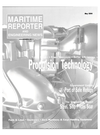
JRC Proposes Integrated Nautical Safety System
In the past decade more than 25,000 accidents have been caused by ships maneuvering under adverse environmental or traffic conditions. A leading cause of many of these accidents - by some estimates up to 70 or 80 percent - are due to "human error," confirmed by the fact that international organizations such as the International Maritime Organization (IMO) are dedicating significant time and resources to studying the problem and developing solutions.
The marine electronics community has used this trend to steadily build complete bridge systems which are increasingly integrated "plug and play" units. A high level of corporate consolidations has significantly aided this trend.
An example of complete integration is the Integrated Nautical Safety Systems - dubbed OceanExplorer II - from Japan Radio Co. OceanExplorer II is designed to reduce, by ergonomic improvement, the working environment such as the design of the workstation and the man/machine interfaces. It is, in principle, designed in accordance with DNV NAUT -AW and adopts their characteristics to support safer voyages.
The arrangement of the integrated workstations ensures that all instrumentation and controls necessary to perform tasks are within reach, easily accessible and immediately or easily readable, depending on their determined function.
In particular, "within reach" should be allocated those instruments and controls that will be used most frequently.
Any changes of the environment, including surrounding ships and sea conditions, can be easily recognized by ship personnel immediately on the bridge which is design decided ergonomically.
The JRC ECDIS JAN-901 ECR is designed to display radar video, electronic chart and nautical information.
The electronic chart is able to display two different areas simultaneous in different chart scales to monitor ships progress or destination, and track review as Windows.
The Track Control System with OceanExplorer II (ie. Automatic- Navigation & Track Keeping systems | ANTS]) is designed to achieve reliable, economical and safe voyages, particularly in narrow channels, with ECDIS.
The track accuracy is kept by high performance processing of real-time data from GPS, speed log, gyrocompass (rate of turn), rudder order/response, and controlling ships course and position to minimize difference from the planned route on the software of the ECDIS.
The chart radar is a harmonized system with ECDIS. All nautical information necessary is in one display, which effectively helps to reduce human errors. Also, this may help to minimize a number of displays on the bridge. The duplication of this multi-function radar also increases redundancy.
Circle 2 on Reader Service Card
Read JRC Proposes Integrated Nautical Safety System in Pdf, Flash or Html5 edition of May 2004 Maritime Reporter
Other stories from May 2004 issue
Content
- Fincantieri Delivers Westerdam page: 10
- "World's Largest" Heavy Lift Ship Enters Service page: 10
- Damen Delivers Pair of Tugs page: 10
- Not Just Another Dam Ship page: 12
- Welsh Towing Company Growth Continues page: 14
- Gladding-Hearn Starts Construction of New I neat Vessel page: 15
- Despite 11% Increase, Hempel Disappoints page: 15
- Grimaldi-Naples Receives GM Award page: 16
- Schlueter Promoted to VP page: 17
- Misplacing the Place of Refuge page: 20
- Schottel Broadens Electric Propulsion Options page: 26
- CIMAC Congress Set for Kyoto page: 29
- Waterjets for a Difficult Design Task page: 30
- New Shaft Seal from Ocean Venture Seals page: 31
- Gas Turbines: Keeping Fresh With Innovation page: 32
- MAN B&W Diesel Debuts the New S65ME-C page: 33
- Thordon COMPAC Finds Success in FSV page: 33
- Wartsila to Power Australian FPSO page: 34
- VSP: Same Power, 9% More Bollard Pull page: 35
- The New MTU 2000 CR Marine Engines page: 36
- Converting and Repowering One Very Big Ship page: 38
- Power for a New Breed of RoPax page: 40
- ZF Helps to Harness Spirit of Ontario's Power page: 41
- Greece Poised for Posidonia 2004 page: 42
- Leif Hoegh Records Strong First Quarter page: 43
- BV Launches LNG CAP page: 43
- Steel, Ship Prices Soar as Tankers Stay Firm page: 44
- Ice Class & Large Ships Pose New Challenges page: 44
- Royal Caribbean Stays Current with C-MAP CM-93/3 ECs page: 46
- JRC Proposes Integrated Nautical Safety System page: 46
- C-Map's RTU and the Ending of the Paper Trail page: 47
- AutoChief C20 Reports Good Market Penetration page: 48
- Vision FT IBS page: 48
- Research Winches for R/V Maria S. Merian page: 52
- Konecranes Giving Port Efficiency a Lift page: 52
- Chinese Yard Logs Strong Month page: 55
- Fuel Oil Separation Takes Center Stage page: 56
- Security of Ports and Vessels: A New Approach page: 60


